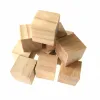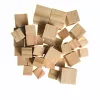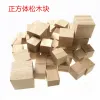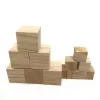Unleash Your Creativity with 1 cm Wood Cubes: Versatile Blocks for Art, Math & Play
1 cm wood cubes are versatile tools for building foundational math skills and fostering creativity in young children. These blocks can be used for counting, sorting, patterning, and introducing early geometry concepts such as shape recognition. By engaging in fun activities with these blocks, children can develop their math skills while enjoying themselves. Additionally, open-ended play with 1 cm wood cubes provides limitless opportunities for imaginative building and exploration. Unstructured play has numerous benefits for childhood development, including improving problem-solving skills and fostering creativity. Children can also participate in games such as tower-building competitions or cooperative building challenges to enhance social skills and teamwork. With their endless possibilities for learning and play, 1 cm wood cubes are a must-have for any young child’s toy collection.






Math
Counting is one of the most fundamental math skills, and 1 cm wood cubes are perfect for helping children learn to count. Children can count the blocks themselves, or they can be used to count objects in a larger set. For example, you might give a child a set of ten blocks and ask them to count out five, or you might give them a pile of toys and have them use the blocks to count how many there are.
Sorting is another important skill that can be developed using 1 cm wood cubes. Children can sort the blocks by color, shape, size, or any other attribute you choose. For example, you might give a child a set of blocks in different colors and ask them to sort them into groups by color. Or you might give them a set of blocks in different shapes and ask them to sort them into groups by shape.
Patterning is a more advanced concept, but it can also be taught using 1 cm wood cubes. Children can create patterns using the blocks, either by copying existing patterns or by creating their own. For example, you might give a child a set of blocks in different colors and ask them to create a pattern that goes red, blue, green, red, blue, green. Or you might give them a set of blocks in different sizes and ask them to create a pattern that goes small, medium, large, small, medium, large.
Finally, geometry can also be taught using 1 cm wood cubes. Children can use the blocks to create two- and three-dimensional shapes, such as squares, rectangles, triangles, and cubes. They can also use the blocks to explore concepts like symmetry and angles. For example, you might ask a child to use the blocks to create a square, or you might ask them to build a cube and then measure the angles at each corner.
Play
One of the biggest benefits of unstructured play in childhood development is the opportunity for children to explore their own creativity and imagination. By giving kids the freedom to build and create whatever they want with 1 cm wood cubes, they can develop problem-solving skills, spatial reasoning abilities, and critical thinking skills. Additionally, since there are no rules or instructions to follow, children are free to experiment with different ways of stacking, balancing, and arranging the blocks, which can help them learn more about cause-and-effect relationships and how things work together.
There are countless games and activities that can be played with 1 cm wood cubes, and each one offers a unique way to engage children’s minds and foster creativity. For example, children might enjoy building towers or structures, creating their own abstract sculptures, or using the blocks to construct miniature scenes or dioramas. They might also enjoy combining the blocks with other materials, such as cardboard boxes or paper cups, to create even more complex structures.
Beyond the educational benefits, playing with 1 cm wood cubes can also be a fun and relaxing way for children to unwind and release stress. Since there are no requirements to follow or objectives to achieve, children are free to explore and experiment at their own pace, without any pressure or stress.
Overall, if you’re looking for a simple and engaging way to encourage open-ended play and spark your child’s creativity, 1 cm wood cubes can be an excellent choice. With endless possibilities for building and imagination, these tiny wooden blocks offer a world of opportunities for children to explore and learn. So why not give them a try today and see what kind of amazing creations your child can come up with?
FAQ
Q1. What are 1 cm wood cubes and how can they be used for art, math, and play?
Q1 cm wood cubes are small wooden blocks that measure 1 cm in length, width, and height. They are versatile building blocks that can be used for various purposes such as art, math, and play. They are excellent tools for creative exploration and problem-solving activities.
Q2. How can 1 cm wood cubes be used for art?
Q1 cm wood cubes can be used for a variety of art projects. They can be painted, glued together, or used to create sculptures. They can also be used for collage projects, mosaic art, or mixed media artwork. The possibilities are endless, and the small size of the cubes allows for intricate details and precise designs.
Q3. How can 1 cm wood cubes be used for math?
Q1 cm wood cubes are excellent tools for teaching math concepts. They can be used for counting, sorting, graphing, and measuring. They can also be used to teach geometry, fractions, and shapes. Additionally, using 1 cm wood cubes in math activities can help children develop spatial reasoning skills and improve their problem-solving abilities.
Q4. How can 1 cm wood cubes be used for play?
Q1 cm wood cubes can be used for open-ended play and imaginative activities. Children can use them to build structures, create patterns, or invent their own games. Playing with 1 cm wood cubes can help children develop fine motor skills, hand-eye coordination, and spatial awareness. It can also encourage creativity and imagination.



